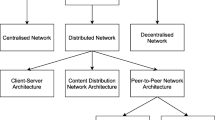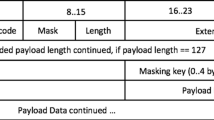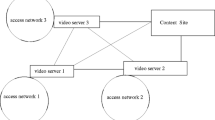Abstract
Originally used as the default infrastructure for efficient file sharing, peer-to-peer (P2P) architecture achieved great successes. Now, the P2P model has been adopted for many other distributed applications, such as instant message and phone services, Internet gaming, and large-scale scientific computing. In recent years, P2P streaming systems experienced tremendous growth and became one of the largest bandwidth consumers on the Internet. Compared to standard file sharing systems, the streaming services show unique characteristics with more stringent time constraints and require much higher network bandwidth. It is extremely important to evaluate and analyze existing applications, and investigate the merits and weaknesses in these systems for future development.
In this paper, we conduct a comprehensive measurement study on two of the most popular P2P streaming systems, namely, PPLive and PPStream. They are very popular P2P streaming applications, and serving millions of registered users with hundreds of live TV channels and millions of other video clips. In our measurement, we deploy our collectors in China, and both live TV and video-on-demand (VoD) channels are evaluated. We record run-time network traffic on the client side, compare and analyze the characteristics of these channels based on their popularity. For both categories, we perceive that, in general, the two measured P2P streaming systems provide satisfactory experience to the audiences for all channels regardless of popularity. However, the most of data are downloaded from the dedicated servers for unpopular channels. We also observe that live TV channels show better peer coordination than VoD channels. Beside the traffic, we have also collected cache replacement information for VoD channels, and these measurement results can help us understand the caching mechanism of P2P streaming systems. With the support of the cache, VoD channels perform better than their counterparts in the live TV category in terms of data transmission, workload distribution, and signal traffic overhead. Overall, our results reveal that although P2P streaming systems can usually provide excellent viewing experience for popular channels, there are still challenges to fully support unpopular channels. New designs and algorithms are in urgent need, especially for unpopular live TV channels.



















Similar content being viewed by others
References
Miniwatts Marketing Group Internet World Stats, http://www.internetworldstats.com/stats.htm
Napster, http://www.napster.com
Edonkey, http://www.edonkey2000.net
BitTorrent, http://www.bittorrent.com
SETI@HOME, http://setiathome.ssl.berkeley.edu
SkyPe, http://www.skype.com
Youtube, http://www.youtube.com
PPLive/PPTV, http://www.pptv.com
Facebook, http://www.facebook.com
Twitter, http://www.twitter.com
Cisco Inc., Cisco visual networking index: forecast and methodology, 2009–2014
Biskupski B, Schiely M, Felber P, Meier R (2008) Tree-based analysis of mesh overlays for Peer-to-Peer streaming. In: Meier R, Terzis S (eds) 8th IFIP international conference on distributed applications and interoperable systems (DAIS’08). Lecture notes in computer science, vol 5053. Springer, Berlin, pp 126–139
Bradai A, Ahmed T (2012) On the optimal scheduling in pull-based real-time p2p streaming systems: layered and non-layered streaming. In: ICC, pp 1981–1985
Liu Y, Guo Y, Liang C (2008) A survey on peer-to-peer video streaming systems. In: Peer-to-peer networking and applications, vol 1, pp 18–28
Liu S-C, Chen TH (2010) Enabling adaptive live streaming in p2p multipath networks. J Supercomput 53(1):26–44
Liu F, Li B, Zhong L, Li B, Jin H, Liao X (2012) Flash crowd in p2p live streaming systems: fundamental characteristics and design implications. IEEE Trans Parallel Distrib Syst 23(7):1227–1239
PPStream, http://www.ppstream.com
UUSee, http://www.uusee.com
SopCast, http://www.sopcast.com
iResearch, http://www.iresearch.com.cn/
Hei X, Liang C, Liang J, Liu Y, Ross KW (2006) Insights into pplive: a measurement study of a large-scale p2p iptv system. In: Proceedings of IPTV workshop, international world wide web conference, Edinburgh, Scotland, May 2006
Vu L, Gupta I, Liang J, Nahrstedt K (2006) Mapping the pplive network: studying the impacts of media streaming on p2p overlays. Tech rep, Computer Science Department, University of Illinois at Urbana-Champaign, August 2006
Liang W, Bi J, Wu R, Li Z, Li C (2009) On characterizing PPStream: measurement and analysis of P2P IPTV under large-scale broadcasting. In: GLOBECOM. IEEE, New York, pp 1–6
WireShark, http://www.wireshark.org
Tcpdump, http://www.tcpdump.org
GnuPlot, http://www.gnuplot.info
APNIC, http://www.apnic.net/
Breslau L, Cao P, Fan L, Phillips G, Shenker S (1999) Web caching and zipf-like distributions: evidence and implications. In: INFOCOM, pp 126–134
Saleh O, Hefeeda M (2006) Modeling and caching of peer-to-peer traffic. In: ICNP, pp 249–258
Ergu D, Kou G, Peng Y, Shi Y, Shi Y (2011) The analytic hierarchy process: task scheduling and resource allocation in cloud computing environment. J Supercomput. doi:10.1007/s11227-011-0625-1
Hei X, Liang C, Liang J, Liu Y, Ross KW (2007) A measurement study of a large-scale p2p iptv system. IEEE Trans Multimed 9:1672–1687
Ali S, Mathur A, Zhang H (2006) Measurement of commercial peer-to-peer live video streaming. In: Proceedings of ICST workshop on recent advances in peer-to-peer streaming, Weaterloo, Canada, August 2006
Liu Y, Guo L, Li F, Chen S (2009) A case study of traffic locality in Internet p2p live streaming systems. In: Proceedings of the IEEE international conference on distributed computing systems (ICDCS), Montreal, Quebec, Canada, June 2009, pp 423–432
Spoto S, Gaeta R, Grangetto M, Sereno M (2009) Analysis of pplive through active and passive measurements. In: Proceedings of the international parallel and distributed processing symposium (IPDPS), Rome, Italy, May 2009, pp 1–7
Zeadally S, Cerqueira E, Curado M, Leszczuk M (2010) Session level analysis of p2p television traces. In: Proceedings of third international workshop on future multimedia networking (FMN), Krakow, Poland, June 2010
Gao P, Liu T, Chen Y, Wu X, El-khatib Y, Edwards C (2008) The measurement and modeling of a p2p streaming video service. In: The second international conference on networks for grid applications (GridNets), Beijing, China, October 2008
Silverston T, Jakab L, Cabellos-Aparicio A, Fourmaux O, Salamatian K, Cho K (2011) Large-scale measurement experiments of p2p-tv systems insights on fairness and locality. Signal Process Image Commun 26(7):327–338
Seibert J, Zage D, Fahmy S, Nita-rotaru C, Experimental comparison of peer-to-peer streaming overlays: an application perspective. Tech rep, Purdue University
PlanetLab: An open platform for developing, deploying and accessing planetary-scale services. http://www.planet-lab.org
Pai V, Kumar K, Tamilmani K, Sambamurthy V, Mohr AE, Mohr EE (2005) Chainsaw: eliminating trees from overlay multicast. In: Proceedings of the 2nd international workshop on peer-to-peer systems (IPTPS), Ithaca, NY, Feburary 2005, pp 127–140
Castro M, Druschel P, Kermarrec A-M, Nandi A, Rowstron A, Singh A (2003) SplitStream: high-bandwidth multicast in cooperative environments. In: Proceedings of the nineteenth ACM symposium on operating systems principles (SOSP), Bolton Landing, NY, October 2003, pp 298–313
Mu M, Ishmael J, Knowles W, Rouncefield M, Race NJP, Stuart M, Wright G (2012) P2p-based iptv services: design, deployment, and qoe measurement. IEEE Trans Multimed 14(6):1515–1527
Ethereal, http://www.ethereal.com
Li B, Ma M, Jin Z, Zhao D (2012) Investigation of a large-scale p2p vod overlay network by measurements. Peer-to-Peer Networking Appl 5(4):398–411
Ciullo D, Mellia M, Meo M, Leonardi E (2008) Understanding p2p-tv systems through real measurements. In: Proceedings of IEEE global communications conference (GLOBECOM), New Orleans, LA, November–December 2008, pp 2297–2302
Joost, http://www.joost.com
Kermarrec AM, Merrer E, Liu Y, Simon G (2009) Surfing peer-to-peer iptv: distributed channel switching. In: Proceedings of the 15th international euro-par conference on parallel processing (Euro-par), Delft, The Netherlands, August 2009, pp 574–586
Acknowledgements
This work is supported by National Natural Science Foundation of China under grants 61173170 and 60873225, National High Technology Research and Development Program of China under grant 2007AA01Z403, Innovation Fund of Huazhong University of Science and Technology under grants 2012TS052 and 2012TS053, science and technology research project of the education department of Hubei province under grant B2013205.
Author information
Authors and Affiliations
Corresponding author
Rights and permissions
About this article
Cite this article
Gao, G., Li, R., Xiao, W. et al. Measurement study on P2P streaming systems. J Supercomput 66, 1656–1686 (2013). https://doi.org/10.1007/s11227-013-0959-y
Published:
Issue Date:
DOI: https://doi.org/10.1007/s11227-013-0959-y




